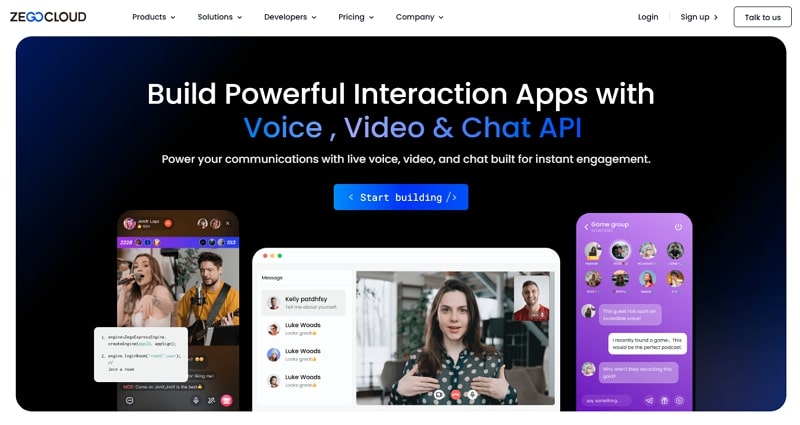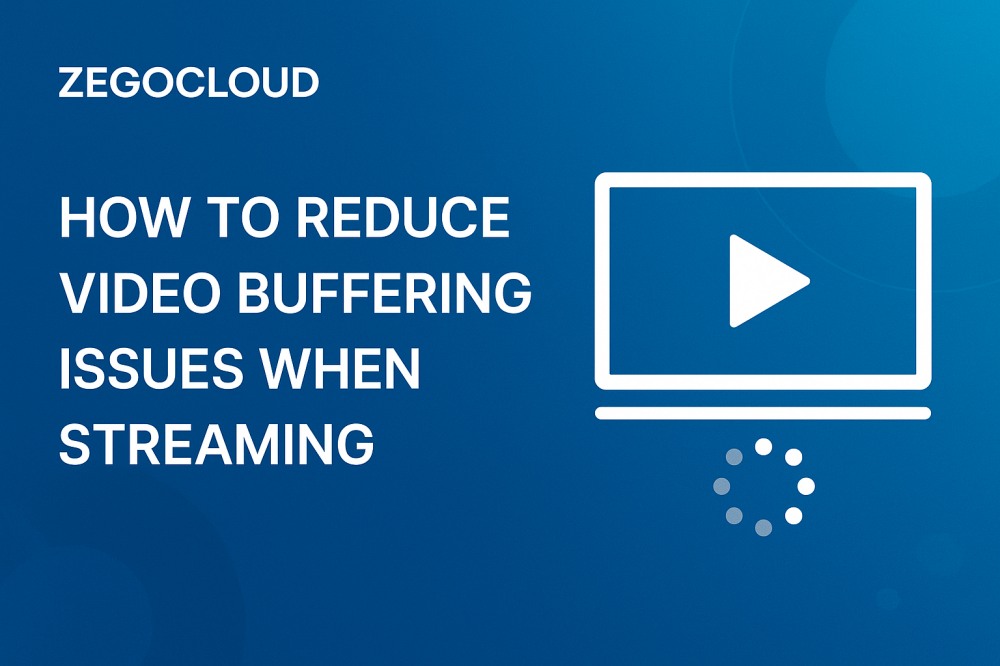Video buffering remains one of the most common and disruptive issues in online video delivery. For streaming platforms, buffering not only affects user experience but also leads to reduced engagement, higher churn rates, and lost revenue. In this article, we’ll explore the core causes of video buffering and outline actionable solutions developers can implement to reduce buffering and improve stream stability—especially in large-scale or real-time scenarios.
What is Video Buffering?
Video buffering occurs when the playback buffer doesn’t receive data fast enough to maintain continuous streaming. This typically happens when network bandwidth, device processing power, or server responsiveness cannot keep up with the video bitrate. Buffering is especially common during high-resolution streaming, on unstable networks, or during peak traffic hours.
What are the Causes of the Video Buffering Issue?
Various factors can cause this dilemma, and knowing them helps you resolve the problem to enjoy better viewing. Below, we will explore some key causes that can lead to this dilemma on your side:
- Insufficient Network Bandwidth: The first reason is a weak internet signal, which cannot load videos fast enough, so streaming pauses to catch up. If you stream in high quality, slow speeds can’t deliver enough data, causing buffering video streaming problems.
- Low Device Performance or Hardware Limits: Old or low-powered devices can’t handle heavy video tasks, even with fast internet speeds. As a result, they struggle to play HD videos smoothly, which results in lag or constant buffering issues.
- Network Congestion: Sometimes, too many people using the same internet connection divide the data, slowing everyone’s connection. Thus, this happens a lot at night or in shared spaces, where video streaming often struggles to stay smooth.
- Unstable or Overloaded Streaming Server: This buffering problem also comes from the server that hosts the video, not your connection. In this situation, heavy traffic or technical problems on the platform can delay playback and cause repeated buffering.
- High Bitrate Video Without Adaptive Streaming: Videos with high detail use more data, which slower internet connections cannot handle well. Hence, buffering issues will occur during streaming every time the file sends data faster than your internet allows.
Why Should You Stop Video Buffering for a Streaming Business?
Video buffering isn’t just a user inconvenience—it’s a direct threat to platform performance, user retention, and revenue. For B2B platforms offering video communication, live shopping, virtual events, or media delivery, uninterrupted playback is a core part of the product experience. Here’s why eliminating buffering should be a priority:
- User Retention & Satisfaction
Frequent buffering disrupts viewing and causes frustration, leading to higher churn rates. Smooth playback increases user satisfaction, resulting in longer session times and better retention. - Brand Credibility & Professionalism
Poor playback reflects poorly on your platform’s technical capabilities. Inconsistent streams can harm your brand image, especially in enterprise or customer-facing scenarios. - Monetization & Conversion Rates
Buffering delays lower engagement during critical moments—such as in live commerce or online training—directly impacting conversion rates and ROI. - Operational Efficiency
Repeated playback failures lead to more user complaints, support tickets, and rewatch attempts, which increase server loads and operational costs. - Data Integrity
Buffering distorts watch time, engagement, and completion metrics, making it harder to make informed business and content decisions.
How to Reduce Video Buffering Issues
Reducing video buffering is crucial for delivering a smooth and engaging streaming experience— especially for platforms handling live shopping, real-time events, or high-traffic video content. Below are proven technical strategies developers can apply to minimize buffering and enhance overall playback quality:
1. Implement Adaptive Bitrate Streaming (ABR)
Adaptive Bitrate Streaming dynamically adjusts the video quality in real time based on the user’s current network conditions. This ensures smooth playback without pauses, even when bandwidth fluctuates. By using ABR, your platform can automatically downgrade resolution instead of stalling the stream—greatly improving perceived quality of experience (QoE).
2. Optimize CDN and Edge Delivery
Using a reliable CDN with globally distributed edge nodes helps reduce latency and speeds up content delivery. Choose a CDN provider that supports intelligent routing and allows you to cache content closer to the end user. This is especially important for global platforms or those running live events.
3. Fine-Tune Buffer Settings
Adjusting your player’s buffer strategy can reduce the impact of short-term network drops. For example, increasing the initial preload buffer and setting an optimal maximum buffer size helps maintain continuous playback during mild interruptions. Balance is key: too much buffering causes delay; too little increases rebuffering risk.
4. Monitor Real-Time Network Metrics
Integrate real-time monitoring tools to track key metrics such as packet loss, latency, jitter, and bitrate shifts. These insights allow your system to react dynamically—such as switching to a lower-quality stream or triggering preemptive buffering—before users notice playback issues.
5. Use Reliable Streaming Protocols
Switching to low-latency protocols like WebRTC, QUIC, or Low-Latency HLS (LL-HLS) can significantly improve responsiveness and reduce playback delay. These protocols are designed to handle real-time communication more efficiently than traditional HTTP-based streaming.
6. Enable Server-Side Load Balancing
For large-scale streaming platforms, distributing user traffic across multiple servers using load balancing ensures consistent performance. This prevents single server overloads that can slow down or disrupt streaming for end users.
How ZEGOCLOUD Helps You Minimize Buffering in Live Streaming
Video buffering severely impacts the viewer experience negatively, whether it’s on-demand video or live streaming. So, ZEGOCLOUD minimizes buffering through its ultra-low latency global network, which covers over 200 countries. It achieves a minimal latency of 300ms to reduce the delay between broadcasts. Moreover, with over 500 edge nodes, the platform routes data using network analysis to find the most efficient transmission paths.

Besides, ZEGOCLOUD uses adaptive bitrate streaming that adjusts video quality based on the bandwidth. This technology can reduce buffering by up to 70%, as it lowers the resolution during a poor network. In addition, once the network stabilizes, the system automatically restores higher resolution. Moreover, ZEGOCLOUD’s edge computing infrastructure features local acceleration nodes in key regions.
This facility helps reduce content delivery time by up to 40% as compared to old centralized servers. Plus, this proximity to end users minimizes latency and packet loss for reliable streams. Having service uptime of 99.99% and scalable solutions, ZEGOCLOUD delivers high-quality live streaming with minimal buffering.
Conclusion
In summary, video buffering is not just a user inconvenience—it’s a critical performance issue that directly impacts streaming platforms’ engagement, retention, and growth. For businesses building real-time video applications, addressing buffering through infrastructure optimization, adaptive streaming, and low-latency protocols is essential. With ZEGOCLOUD’s robust RTC and CDN architecture, developers can significantly reduce buffering and deliver a seamless viewing experience—even under unstable network conditions.
FAQ
Q1: How can I reduce buffering in my video streaming app?
To reduce buffering, implement adaptive bitrate streaming (ABR), optimize buffer settings, and use a reliable CDN with edge nodes close to users. Also, monitor real-time QoS metrics like latency, jitter, and packet loss to adjust playback dynamically.
Q2: What’s the difference between buffering and latency?
Buffering refers to interruptions in playback when the stream can’t keep up with real-time delivery. Latency is the delay between the source sending content and the viewer receiving it. High latency doesn’t always cause buffering, but both affect user experience.
Q3: How can I detect when buffering occurs on the client side?
Use client-side analytics or player SDKs (e.g. HLS.js, Video.js) that expose buffer events, playback state, and buffer length. These events help you track buffering frequency and duration in real time.
Q4: Does using WebRTC help reduce buffering?
Yes, WebRTC is designed for low-latency, real-time communication and generally experiences less buffering than traditional HTTP-based streaming. However, it requires a stable P2P or relay server setup and may not be ideal for all broadcast use cases.
Let’s Build APP Together
Start building with real-time video, voice & chat SDK for apps today!










